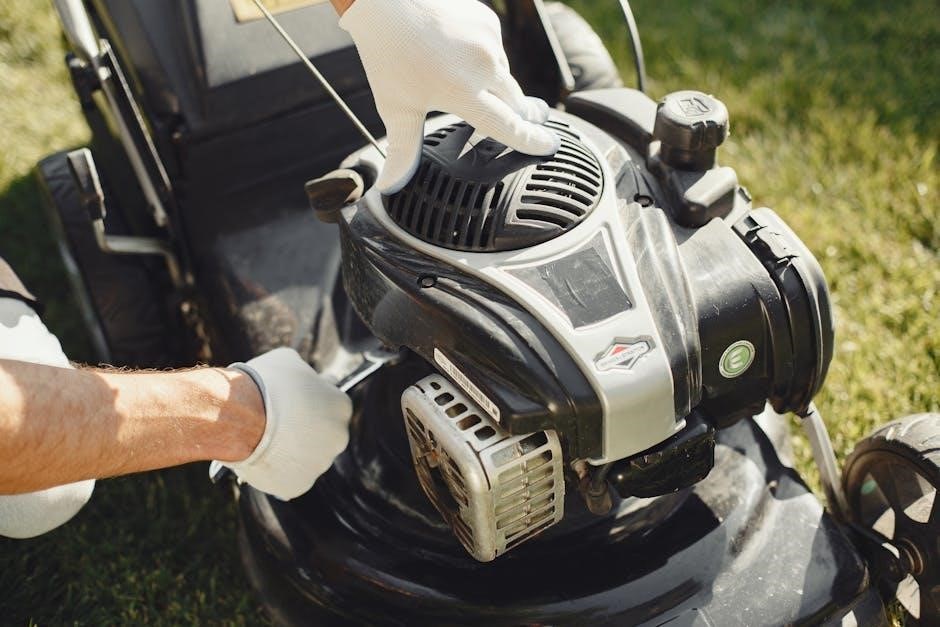Gravely Zero Turn Mower Manual: A Comprehensive Guide
This guide provides essential information for Gravely zero-turn mower owners‚ covering model identification‚ maintenance‚ parts lookup‚ and safety procedures for all models.
Understanding Your Gravely Zero Turn Mower

Gravely zero-turn mowers are known for their durability and performance‚ but understanding your specific model is crucial for optimal operation. Locating the model and serial number‚ typically found on the main frame under the seat or near the battery‚ is the first step.
This information is vital for accessing the correct manual‚ ordering replacement parts‚ and ensuring proper maintenance. Knowing your mower’s specifics allows for targeted troubleshooting and maximizes its lifespan.
Locating the Model and Serial Number
Model and serial number labels on Gravely zero-turn mowers are affixed to the main frame of the unit. For modern units‚ expect a small‚ white sticker – about the size of a business card – usually positioned under the seat‚ close to the battery box.
These labels are essential for parts lookup and accessing the correct manual. Carefully inspect these areas to find the necessary information for your specific Gravely mower.
Manual Access and Resources
Gravely provides convenient access to manuals and resources for its zero-turn mowers. Start with the official Gravely website‚ where you can often download manuals directly using your model number.
Additionally‚ several third-party repositories may host archived manuals. Utilizing these resources ensures you have the necessary documentation for maintenance‚ troubleshooting‚ and safe operation of your Gravely machine.
Official Gravely Website and Manual Downloads
Gravely’s official website is the primary source for operator’s manuals and parts lists. You can easily locate your mower’s manual by entering the model number into the search function.
Downloads are typically available in PDF format‚ allowing for easy viewing and printing. This ensures you have immediate access to crucial information regarding operation‚ maintenance‚ and safety guidelines specific to your Gravely zero-turn model.
Third-Party Manual Repositories
While Gravely’s website is preferred‚ several third-party websites archive operator manuals. These repositories can be helpful if you encounter difficulties finding your specific Gravely zero-turn mower manual.
However‚ always verify the manual’s accuracy by cross-referencing it with your model and serial number. Be cautious of outdated or incomplete information‚ and prioritize using the official Gravely documentation whenever possible for reliable guidance.
Key Components and Their Functions
Gravely zero-turn mowers feature robust engines requiring specific maintenance‚ like oil changes and air filter cleaning. The cutting deck is central‚ with adjustable heights for varying grass lengths. Understanding these components—from the engine specifications to deck adjustments—is crucial.
Proper function ensures optimal performance and longevity. Familiarize yourself with each part’s role for effective operation and troubleshooting.
Engine Specifications and Maintenance
Gravely mowers utilize various engine brands and sizes; consult your model’s documentation for specifics. Regular maintenance includes checking oil levels‚ replacing filters (air‚ fuel‚ oil)‚ and inspecting spark plugs. Adhering to the recommended schedule—typically every 25-50 hours of operation—ensures optimal engine performance.
Proper maintenance extends engine life and prevents costly repairs.
Cutting Deck Overview and Adjustments
Gravely cutting decks vary by model—ZT X‚ Pro Stance‚ Compact‚ and ZT HD series each have unique designs. Understanding blade engagement‚ deck height adjustment‚ and leveling procedures is crucial for a quality cut. Regularly inspect blades for sharpness and damage‚ replacing them as needed.

Proper adjustments optimize cutting performance and deck longevity.
Operating Instructions
Before each use‚ conduct thorough pre-operation checks‚ including fluid levels‚ tire pressure‚ and ensuring all safety devices are functional. Familiarize yourself with the controls—steering levers‚ blade engagement‚ and speed settings—before starting the engine.
Follow the correct starting and stopping procedures outlined in your Gravely manual for safe operation.
Pre-Operation Checks
Prior to each mowing session‚ meticulously inspect the Gravely mower. Verify adequate fuel and oil levels‚ and check the tire pressure for optimal performance. Ensure the cutting deck is free of obstructions and all safety shields are securely in place.
Confirm the battery connections are tight and the seat switch functions correctly for safe operation.
Starting and Stopping Procedures

To start your Gravely‚ ensure the parking brake is engaged and the blades are disengaged. Turn the ignition key to the “on” position and follow the specific starting sequence for your model – typically involving a safety interlock and throttle control.
For stopping‚ disengage the blades‚ reduce the throttle‚ and apply the parking brake before turning off the ignition.
Maintenance Schedule
Regular maintenance is crucial for optimal performance. Daily‚ inspect fluid levels and clean the mower deck. Weekly‚ check tire pressure and blade sharpness. Seasonally‚ change the engine oil‚ filters‚ and belts.
Annual servicing should include a thorough inspection of all components and a professional tune-up. Adhering to this schedule ensures longevity and reliable operation of your Gravely.
Regular Maintenance Tasks
Consistent upkeep extends your mower’s life. Daily‚ clear debris from the deck. Weekly‚ inspect and tighten any loose bolts or fasteners. Check the tire pressure for even wear and optimal handling. Monthly‚ grease all lubrication points and examine belts for cracks or wear.
Regularly cleaning the air filter ensures efficient engine operation. Maintaining these tasks prevents costly repairs and maximizes performance.
Seasonal Maintenance Procedures
Before storing for winter‚ stabilize the fuel or drain the tank completely to prevent gumming. Change the engine oil and filter‚ and inspect the cooling system. Sharpen or replace the cutting blades for optimal performance next season. Clean the entire mower thoroughly‚ removing grass and debris.
In spring‚ check the battery and charging system. Inspect belts and hoses for damage. Ensure all safety features are functioning correctly before the first use.
Troubleshooting Common Issues
Engine problems like failure to start often stem from a dirty air filter‚ old fuel‚ or a faulty spark plug. Cutting deck issues‚ such as uneven cuts‚ may indicate dull blades or a deck that isn’t level; Check the belts for proper tension and wear.
Consult the manual for specific diagnostic steps and always disconnect the spark plug before performing any maintenance. Address issues promptly to prevent further damage.
Engine Problems
Common engine issues include failure to start‚ rough running‚ or a loss of power. Check the fuel level and ensure fresh fuel is being used. A clogged air filter restricts airflow‚ hindering performance. Inspect the spark plug for fouling or damage‚ replacing it if necessary.
Verify proper oil levels and consider a fuel stabilizer for storage. Consult the manual for specific troubleshooting steps related to your engine model.
Cutting Deck Issues
Uneven cutting often stems from dull or damaged blades; sharpen or replace them as needed. Check blade balance to prevent excessive vibration. Inspect the deck for obstructions like accumulated grass or debris‚ which can affect cut quality.
Ensure proper deck leveling for a consistent cut. Refer to the manual for correct blade installation and deck adjustment procedures. Address any bent or damaged deck components promptly.
Parts Lookup and Replacement
Gravely offers a comprehensive OEM parts source‚ ensuring compatibility and quality. Utilize their parts lookup tool‚ accessible online‚ by entering your specific model number. Alternatively‚ search by part number or descriptive name.
Accurate model identification is crucial for correct parts selection. Locate the model number label on your mower’s frame. Benefit from free shipping on orders exceeding $39.99. Refer to diagrams for proper component placement during replacement.
Using the Model Number for Parts Identification
Your Gravely mower’s model number is essential for accurate parts identification. This unique code ensures you order the correct components for your specific machine. Locate the label‚ typically a small white sticker‚ under the seat or near the battery box on modern units.
Input this number into Gravely’s online parts lookup tool. Confirm the model displayed matches your mower before proceeding. Using the correct model number prevents delays and ensures a successful repair.
Gravely OEM Parts Source
Gravely is the premier source for genuine Original Equipment Manufacturer (OEM) parts‚ guaranteeing quality and compatibility with your zero-turn mower. Access their parts lookup system via the official Gravely website‚ utilizing your mower’s model number for precise results.
Benefit from detailed diagrams and accurate part listings. Enjoy free shipping on orders exceeding $39.99. Choosing OEM parts ensures optimal performance and prolongs the life of your Gravely machine.
Safety Precautions
Prioritize safety when operating your Gravely zero-turn mower. Always read and understand the operator’s manual before use. Ensure bystanders are kept at a safe distance during operation. Never operate the mower under the influence of drugs or alcohol.
Inspect the mowing area for obstacles. Utilize appropriate personal protective equipment‚ including eye and hearing protection. Be aware of the mower’s specific safety features and follow all guidelines.
General Safety Guidelines
Always disconnect the spark plug wire before performing any maintenance or adjustments. Never allow children to operate the mower. Keep hands and feet away from the cutting deck while the engine is running. Inspect the mower before each use for loose parts or damage.
Avoid operating on steep slopes or uneven terrain. Be cautious when operating near obstacles. Ensure proper ventilation when working with fuel. Follow all local safety regulations.

Specific Safety Features
Gravely zero-turn mowers incorporate several safety features‚ including a blade engagement system designed to prevent accidental activation. Rollover Protection Systems (ROPS) are available on select models‚ enhancing operator safety. Seat switches disable the engine when the operator leaves the seat.
Ensure these features are functioning correctly before each use. Regularly inspect the ROPS for damage. Understand the operation of the blade engagement system. Never tamper with or disable safety devices.

Serial Number Breakdown (Historical Models)
Understanding the serial number of older Gravely mowers helps determine the manufacturing year and specific model details. For 1962 models‚ the range is M-75701 to M-90897. 1963 units fall between M-90897 and 2M4745. 1964 is 2M4745 to 2M18900‚ while 1965 spans 2M18901 to 2M34215.
Finally‚ 1966 models are identified by serial numbers 2M34216 to 2M51800. This breakdown assists in parts identification and accessing appropriate historical documentation.
1962-1966 Serial Number Ranges
Detailed serial number ranges for Gravely mowers manufactured between 1962 and 1966 are crucial for accurate identification. 1962 models range from M-75701 to M-90897. In 1963‚ the range shifted to M-90897 through 2M4745. 1964 units are 2M4745 to 2M18900‚ followed by 1965’s 2M18901 to 2M34215.
Lastly‚ 1966 models fall within 2M34216 and 2M51800. Utilizing these ranges ensures correct parts ordering and service information retrieval for these vintage Gravely machines.
Zero Turn Specific Features

Gravely’s zero-turn mowers boast unique features across different series. The ZT X and ZT XL models offer enhanced maneuverability and comfort. Pro Stance models deliver professional-grade cutting performance‚ while Compact versions prioritize space-saving design;
Furthermore‚ the ZT HD‚ PT Z‚ and PT ZX series provide robust durability and power for demanding applications. Understanding these distinctions is vital for optimizing performance and maintenance.
ZT X and ZT XL Models

ZT X and ZT XL series Gravely mowers are engineered for superior handling and operator comfort. These zero-turn machines feature responsive controls and a stable platform‚ ideal for residential and light commercial use. They excel in navigating obstacles and achieving precise cuts.
Regularly inspect the steering components and ensure proper tire inflation for optimal performance. Refer to the manual for specific maintenance schedules tailored to these models.
Pro Stance and Compact Models
Pro Stance and Compact Gravely mowers deliver professional-grade cutting performance in versatile packages. The Pro Stance offers exceptional maneuverability and cut quality‚ favored by landscaping professionals. Compact models are perfect for smaller properties and tight spaces.
Pay close attention to blade maintenance and deck leveling for these models. Consult the manual for detailed instructions on adjusting cutting heights and ensuring optimal blade performance.
Understanding Different Gravely Models
Gravely offers a diverse range of zero-turn mowers‚ including the ZT HD‚ PT Z‚ and PT ZX series. ZT HD models are built for demanding jobs‚ offering robust construction and powerful engines. PT Z and PT ZX series provide a balance of performance and comfort.

Each series has unique features; therefore‚ always refer to the specific manual for your model to understand its capabilities and maintenance requirements.
ZT HD‚ PT Z & PT ZX Series
ZT HD mowers are known for their heavy-duty capabilities‚ ideal for professional landscapers. PT Z and PT ZX series offer enhanced operator comfort alongside professional-grade performance. These Gravely models feature robust frames and powerful engines.

Consult your specific model’s manual for detailed information regarding engine specifications‚ cutting deck adjustments‚ and recommended maintenance schedules. Proper maintenance ensures longevity and optimal performance.
Finding Your Model Number
Locating your Gravely mower’s model number is crucial for accessing the correct manual and ordering replacement parts. On modern units‚ the model and serial number label is typically a small‚ white sticker.
This sticker is usually found under the seat‚ positioned near the battery box. It’s essential for accurate parts lookup and ensuring compatibility. Keep this number readily available for all service inquiries.
Location of the Model Number Label
For the zero-turn product line‚ the model and serial number labels are consistently placed on the main frame of the unit. Specifically‚ on modern Gravely units‚ expect to find a small‚ white sticker – about the size of a business card.
This label is commonly situated under the operator’s seat‚ in close proximity to the battery box. Knowing this precise location simplifies model identification and parts sourcing.
Identifying the Label Type (Modern Units)
Modern Gravely units utilize a distinct label format: a small‚ white sticker‚ generally no larger than a standard business card. This sticker contains crucial information‚ including the model number and serial number‚ essential for maintenance and parts ordering.
Locate this label underneath the seat‚ typically near the battery box. Recognizing this label type streamlines the process of identifying your specific mower and accessing relevant resources.




























































